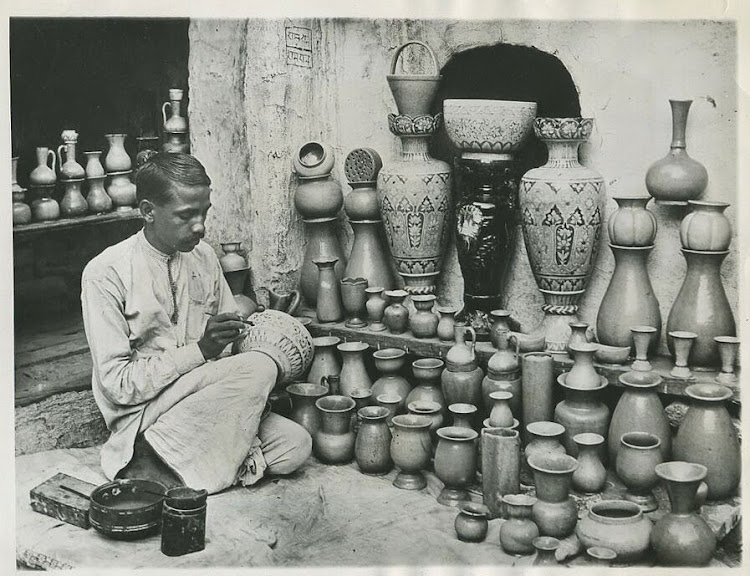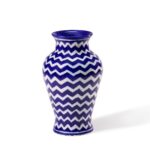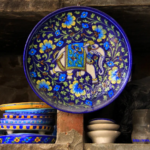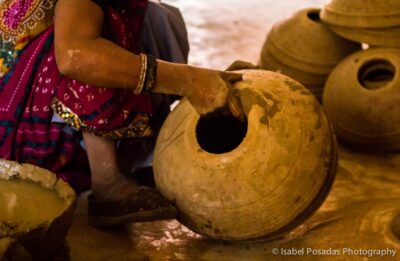Introduction
Oh! The pot is everywhere!
Where there is buttermilk, in the cupboard, A pot
Where water is stored, at the waterstand, A pot
Where food is kept, on the stove, A pot
Where there is jaggery, in the attic
A pot
This is an excerpt from the poem The Pot by Haku Shah, where he describes the importance of a humble earthen pottery, the culture around ceramics and its unyielding presence in human life. This article focuses on the Pottery and ceramic culture of Capital City Delhi with emphasis on world famous Delhi Blue Pottery.

The usage of clay and earthenware is ingrained in Indian culture. Archeological evidences being found as far back as 7000 BCE in Mehargarh. Clay pots are not just used for cooking or carrying water, but every ritual in life – Birth, marriage, death – uses a ceremonial clay vessel. Life is just a lump of clay.
Origins of the art-form

Delhi’s ceramic culture goes as far back as 3rd century BCE. According to Thapar, excavations done at Purana Qila in 1969 resulted in the discovery of Painted Gray Ware pottery sherds around the era of Pre-Mauryan Dynasty. The same mound also gave evidences of different levels of settlement from early Mughal period and Delhi Sultanate to Gupta and Mauryas.
Thapar gives invaluable information about the Pottery remains of each layer. Mauryan period is defined with distinct Northern Black Polished Ware, Gupta period follows the earlier tradition with new additions like painted and molded pottery and lids. The layer of Rajput and Delhi Sultanate rule shows new forms of vase, shallow dishes, lids and bowls, and arrival of Persian pottery culture. The outermost layer of Early Mughal period is defined with Grey Ware jars, Chinese Celadon and Chinese Porcelain.
The Delhi Blue Pottery traces its origin from Egypt, Turkey and Persia, where the use of cobalt blue was very prevalent in ceramics. From their travelling to Afghanistan, it reached Delhi becoming central piece of handicraft for Sultans and Emperors. At first it was used as a glaze for tiles decorating several architectural elements and later was adopted by potters.
How it flourished

Blue pottery is a type of white translucent ceramic that uses vibrant blue colors for creation of intricate designs and motifs. It is the only type of ceramic in the world that doesn’t use clay as its main material. The main ingredient of this beautiful piece of pottery is quartz stone powder often mixed with powdered glass, Katira Gond powder, Multaani Mitti, Saaji, and then thoroughly prepared into a dough with water. It uses cobalt oxide for that rich blue hue.
This labor intensive work before colonial economic destruction was flourishing due to the patronage from Royal elites and less competitive alternative (industrial plastic wares). It was in 1952 that Sardar Gurucharan Singh, with the motive of empowering and educating, opened Delhi Blue Art Pottery. A studio helping aspiring potters and artisans. The Pottery produced here is quite different in their procedure and glaze, according to Rachna Parasher, an alumna of Delhi Blue Pottery Trust. It is heated in 1300 Celsius, instead of 1000 or 900 Celsius as used by other places, giving it a different shine.
The blue pottery easily got famous in Delhi’s household due to its several advantages over earthen red pottery. Due to the outer glaze of Cobalt Oxide it doesn’t break or develop cracks easily. It is impervious and more hygienic, making it suitable for more day to day use without being replaced. It is possible to give blue pottery more detailed designs than the regular clay pottery, giving it both practical and aesthetic usage.
Details about the Motifs used

Motifs and designs in any kind of ceramic culture isn’t just the product of artistic creative freedom but a result of its contemporary environment and socio-political tradition. The decorative and aesthetic appeals hides several beliefs and practices within them. It can reflect religious habits, social structures and natural environment. Some of the prominent motifs of Delhi’s ceramic culture are:-

Geometric patterns: This is the most common design found on Delhi’s clay, terracotta or porcelain vessels. Widely used due to the creative expression it gives while being easy to learn and produce. These patterns are designs made up of lines (straight & wavy), triangles, squares, circles, dots, diamonds, loops, zigzags etc.
Natural patterns: These are more popular among households art collectors due it’s fine detailing and symbolic designs. It can show trees, leaves, vines and different kinds of flowers. It also shows faunal and humanoid elements with animals like elephants, lions, deer etc. and depiction of several gods and goddesses specially in ritual pots.
Current Status

Today the market for handcrafted earthen pots have been diminished due to the availability of several alternative in metal and plastic wares. This was the result of technological advancement and industrial growth. Potters earn subsistence living dangling in poverty where extra expenditure like marriage and unforeseen illness can’t be solved without loans. India’s festive and ritual culture keeps this ancient art form in business, most famous example being festival like Diwali that requires several diyas and matkas in its prayers and rituals.
National Capital provides two broad way of pottery making, the traditional village pottery making in West Delhi and its hub Uttam Nagar and the studio pottery making with organizations like Delhi Blue Art Pottery. Organizations like Indian Ceramic Art Foundation, Delhi Blue Pottery Trust, and Pottery Village Tour organized by Indomania aims to help artisans educationally and promote their business to new markets. It also helps in generating awareness to public and offer workshops and courses in pottery making.
Conclusion
The ceramic culture of India is the result of thousands of years of unbroken tradition since the times of Harappan civilization passing down techniques and tools from generation to generation. One of the most powerful handicraft tradition still existing today due to the resilience of its practitioners and demand of the society’s culture. Delhi’s Blue pottery also shows the mastery of artisans and serves as a testament of city’s enduring legacy.
References
- Perryman, Jane. Traditional Pottery of India. A&C publishers ltd.
- Thapar, B.K. The Buried Past of Delhi. Expedition Magazine, Volume 14(2), pp.21-26.
- Banarjee, Poulomi. Crafted in clay: The art of pottery in Delhi. Hindustan Times.
- Mukherjee, Anushka. Delhi Sculpts the Blues. Deccan chronicle.
- Craftmark Certified Processes: Blue Pottery. All India Artisans and Craftworkers Welfare Association.




